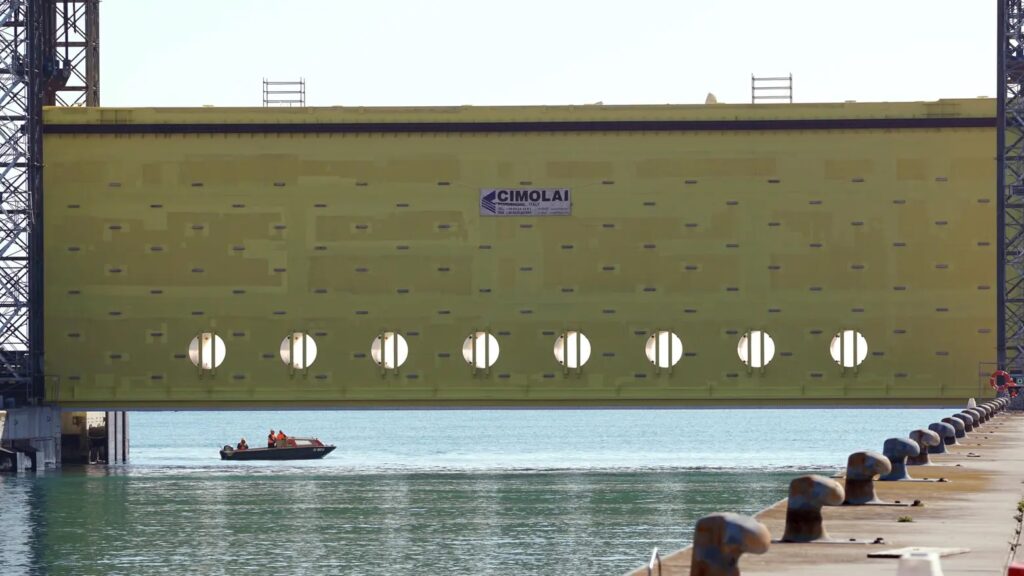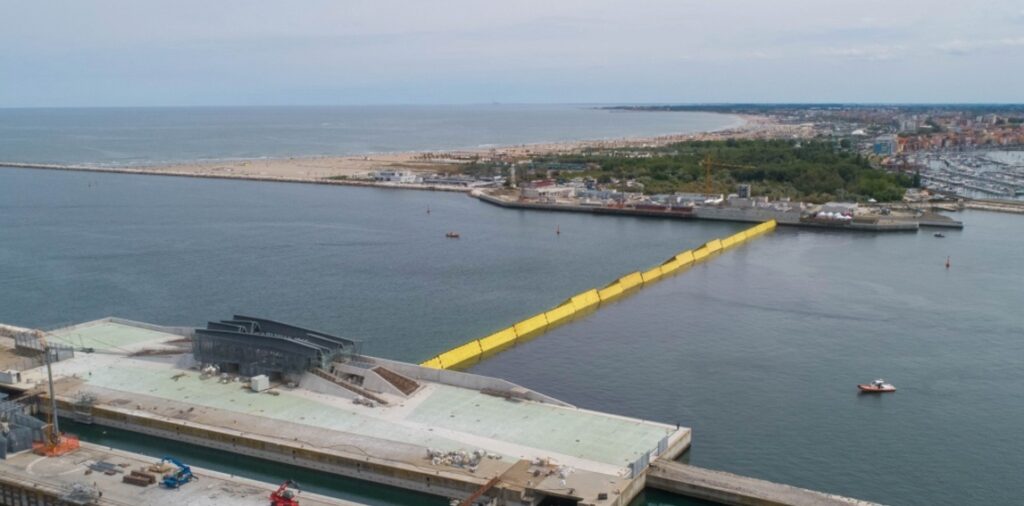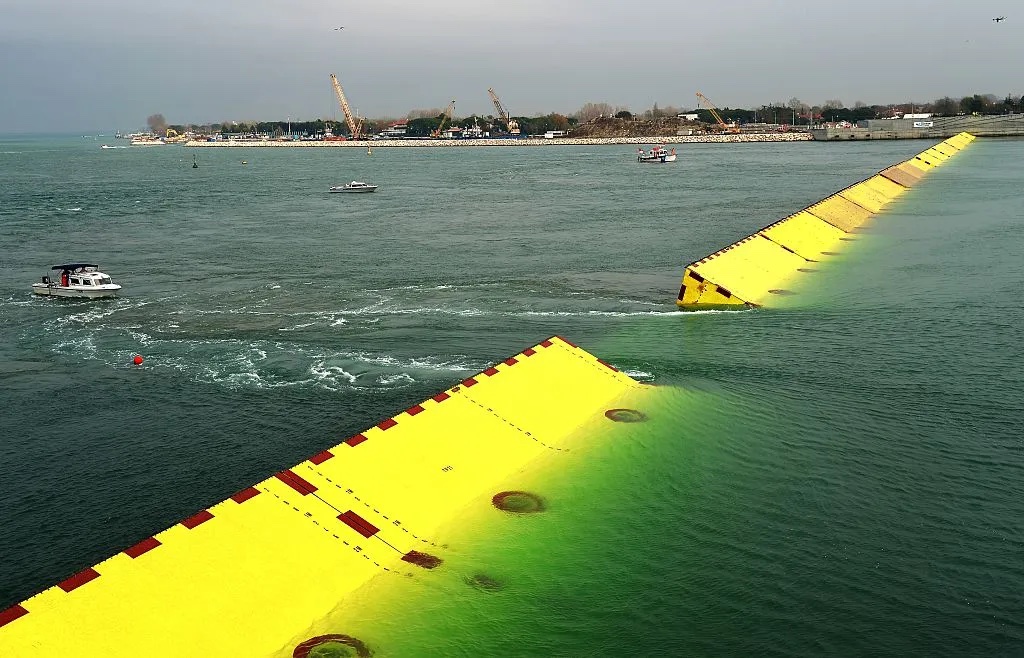It is 17 meters high, 55 meters wide and weighs more than 2 thousand tons: it is the “door” of the navigation basin to the mouth of the port of Malomocco, in Venice, built specifically to allow ships to be able to access the interior of the lagoon even in the presence of high water.
According to the Commissioner Extraordinary for the Mose Elizabeth Spitz this is “a new step forward for the completion of the Mose system”, as well as “a work waiting because it guarantees the full operativity of the port and the commercial traffic also in the phases of closing of the floodgates beginning from the next season of lifts”.
Currently, there are two access gates to the basin of Malomocco: a lagoon side and a side facing the sea that, 8 years ago, was severely damaged and immediately required an inevitable replacement.

As often happens, there have been controversies, especially on the part of Michele Gallo, president of Assoagenti del Veneto: “It is undersized, we have always said”said, referring to the fact that the construction of the entire basin of navigation dates back to the early 2000s, when the ships in transit were much smaller than those now.
To answer him for the rhymes is Tommaso Marella, director of the works of the basin: “At Mose raised the “door” opens by letting in the ship, then closes and, discharged part of the water, opens a second gap to enter the lagoon”, stressing that it should be able to allow the passage of vessels and tugs up to 280 meters long, up to 39 meters wide and with a draft less than 12 meters.
According to initial estimates, the project cost about EUR 300 million.
What is the Mose
The Mose (acronym of Modulo Sperimentale Elettromeccanico) is a work of hydraulic engineering designed and built in Venice to defend its gondolas and its lagoon from floods caused by high water. Its origins date back to November 4, 1966 when the city, in fact, was devastated by a terrible flood: the water, on that occasion, managed to invade 16 thousand homes, paralyze all commercial activities and destroy almost all the glassworks of Murano. According to the Gazette, the damage amounted to about 35 billion old lire just for the historic center.

As a result of what happened, in 1973 the first special law for Venice was passed, which sanctioned once and for all the preservation of the city as a subject of “pre-eminent national interest”.
The origins of the Mose
After the introduction of the special law in 1980, the Minister of Public Works at the time appointed a group of qualified experts to draw up a project to solve the problem; the idea was immediately very clear: it was necessary to focus on the principles of “experimentality”, “reversibility” and “graduality”, introducing new studies and research to each individual step.
The assignment is entrusted in the specific one to the Consortium Venice New, to which the introduction of the mobile floodgates is owed, that is the ideal solution in order to assure the exchange of the water in lagoon and in order not to damage the activity of the port and the peach.

In 1988 the Experimental Electromechanical Module, known as the Mose Module, was presented for the first time and, over the years, has undergone several changes and revisions that have inevitably lengthened its production time. Its approval, however, was immediately absolutely necessary for one reason in particular: the climate change forecasts that, already almost 35 years ago, foreshadowed the rise of water in the coming years.
How does the Mose
But how does the Mose protect Venice from high water? We must first understand that the structure consists of 4 barriers, in turn consisting of 78 independent mobile gates, which have the task of separating the lagoon from the sea when the tide rises and you risk flooding. The gates are located at the 3 mouths of the harbor, that is those natural passages of the coastal cord through which the waters of the Adriatic Sea flow into the lagoon: it is the mouth of Malomocco, the mouth of Chioggia and the mouth of Lido.
These gates are defined as mobile because when the tide is in normal conditions they remain lying on the seabed. Each of them consists of a metal box structure that, when filled with water, remains in a horizontal position on the bottom, inside the “caisson” (ie the structure of the foundation) made of concrete. To make it rise, compressed air is inserted inside it, which sends out the air and, taking advantage of the buoyancy, the door in vertical position.

mosevenezia
This can also happen because the gates are connected to the body by means of hinges, which allow them to rotate and oscillate with ample freedom of movement while maintaining, at the same time, the difference in tide between sea and lagoon.
Each gate is equipped with 4 fenders, which have the task of cushioning its impact on the body and support it when it is at rest. On each edge, instead, have been installed rubber fins that avoid the “air gap”, that is, the air space that is created between a gate and the other. But not only that, because the fins also serve to reduce the accumulation of sediment inside the caisson and to limit the flow of water between sea and lagoon.
Another important element beyond the gates, therefore, is the system of caissons: together, they form the fixed base of the defense barriers, that is of that compartment that houses the mobile gates. They contain compressed air ducts, electromechanical systems, communication and control systems.
How the Mose is maintained
In order for the Mose to function properly and constantly protect the city, a constant maintenance work is indispensable, which consists mainly in the replacement of all the gates every 5 years (therefore approximately 4 gates per year for each barrier). To do this, a special naval vehicle, called Jack-up, was built, which is used both to install and replace the gates.
It is also carried out routine maintenance that provides for the simple cleaning of sluice gates from sand and other deposits, the restoration of paint on damaged surfaces and the replacement of some electromechanical parts.
What does the future of the Mose predict?
According to its design, the Mose is able to protect Venice and its lagoon from tides up to 3 meters high and from a sea rise up to 60 centimeters. The starting idea is part of a larger project that also includes the reinforcement of the coast, the raising of the banks and pavements and the redevelopment of the lagoon.
In 2005 it cost EUR 5.4 billion, but what worries us most today is the future costs of maintenance, which, being barriers kept constantly under water, could be really salty.
It must be said, moreover, that when the Mose will be operational and 100% complete it will be able to come into operation even with tides greater than 110 centimeters, therefore an additional safety for the city and its inhabitants.
It is not possible, therefore, to take stock of what may happen in the coming years. Only one certainty remains: the Mose, with its structure and its functionality, is absolutely essential to preserve a wonderful city like Venice, its commercial activities, its population, tourists and, of course, nature and architectural beauty. The hope is that, regardless of the costs, the Mose can remain active and functioning as long as possible.
Copertina_ ilgazzettino




